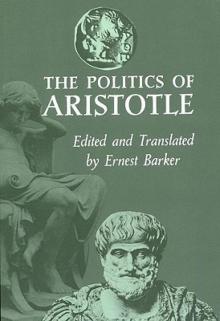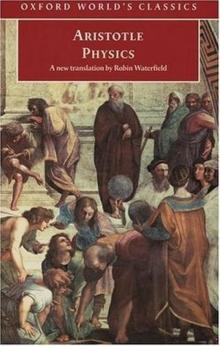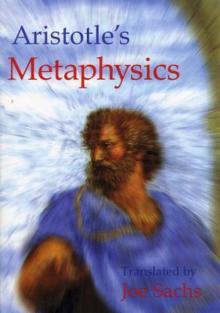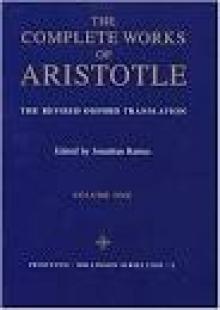Various Works Read online
Page 19
points can neither be one (since of an indivisible there can be no
extremity as distinct from some other part) nor together (since that
which has no parts can have no extremity, the extremity and the
thing of which it is the extremity being distinct).
Moreover, if that which is continuous is composed of points, these
points must be either continuous or in contact with one another: and
the same reasoning applies in the case of all indivisibles. Now for
the reason given above they cannot be continuous: and one thing can be
in contact with another only if whole is in contact with whole or part
with part or part with whole. But since indivisibles have no parts,
they must be in contact with one another as whole with whole. And if
they are in contact with one another as whole with whole, they will
not be continuous: for that which is continuous has distinct parts:
and these parts into which it is divisible are different in this
way, i.e. spatially separate.
Nor, again, can a point be in succession to a point or a moment to a
moment in such a way that length can be composed of points or time
of moments: for things are in succession if there is nothing of
their own kind intermediate between them, whereas that which is
intermediate between points is always a line and that which is
intermediate between moments is always a period of time.
Again, if length and time could thus be composed of indivisibles,
they could be divided into indivisibles, since each is divisible
into the parts of which it is composed. But, as we saw, no
continuous thing is divisible into things without parts. Nor can there
be anything of any other kind intermediate between the parts or
between the moments: for if there could be any such thing it is
clear that it must be either indivisible or divisible, and if it is
divisible, it must be divisible either into indivisibles or into
divisibles that are infinitely divisible, in which case it is
continuous.
Moreover, it is plain that everything continuous is divisible into
divisibles that are infinitely divisible: for if it were divisible
into indivisibles, we should have an indivisible in contact with an
indivisible, since the extremities of things that are continuous
with one another are one and are in contact.
The same reasoning applies equally to magnitude, to time, and to
motion: either all of these are composed of indivisibles and are
divisible into indivisibles, or none. This may be made clear as
follows. If a magnitude is composed of indivisibles, the motion over
that magnitude must be composed of corresponding indivisible
motions: e.g. if the magnitude ABG is composed of the indivisibles
A, B, G, each corresponding part of the motion DEZ of O over ABG is
indivisible. Therefore, since where there is motion there must be
something that is in motion, and where there is something in motion
there must be motion, therefore the being-moved will also be
composed of indivisibles. So O traversed A when its motion was D, B
when its motion was E, and G similarly when its motion was Z. Now a
thing that is in motion from one place to another cannot at the moment
when it was in motion both be in motion and at the same time have
completed its motion at the place to which it was in motion: e.g. if a
man is walking to Thebes, he cannot be walking to Thebes and at the
same time have completed his walk to Thebes: and, as we saw, O
traverses a the partless section A in virtue of the presence of the
motion D. Consequently, if O actually passed through A after being
in process of passing through, the motion must be divisible: for at
the time when O was passing through, it neither was at rest nor had
completed its passage but was in an intermediate state: while if it is
passing through and has completed its passage at the same moment, then
that which is walking will at the moment when it is walking have
completed its walk and will be in the place to which it is walking;
that is to say, it will have completed its motion at the place to
which it is in motion. And if a thing is in motion over the whole
KBG and its motion is the three D, E, and Z, and if it is not in
motion at all over the partless section A but has completed its motion
over it, then the motion will consist not of motions but of starts,
and will take place by a thing's having completed a motion without
being in motion: for on this assumption it has completed its passage
through A without passing through it. So it will be possible for a
thing to have completed a walk without ever walking: for on this
assumption it has completed a walk over a particular distance
without walking over that distance. Since, then, everything must be
either at rest or in motion, and O is therefore at rest in each of the
sections A, B, and G, it follows that a thing can be continuously at
rest and at the same time in motion: for, as we saw, O is in motion
over the whole ABG and at rest in any part (and consequently in the
whole) of it. Moreover, if the indivisibles composing DEZ are motions,
it would be possible for a thing in spite of the presence in it of
motion to be not in motion but at rest, while if they are not motions,
it would be possible for motion to be composed of something other than
motions.
And if length and motion are thus indivisible, it is neither more
nor less necessary that time also be similarly indivisible, that is to
say be composed of indivisible moments: for if the whole distance is
divisible and an equal velocity will cause a thing to pass through
less of it in less time, the time must also be divisible, and
conversely, if the time in which a thing is carried over the section A
is divisible, this section A must also be divisible.
2
And since every magnitude is divisible into magnitudes-for we have
shown that it is impossible for anything continuous to be composed
of indivisible parts, and every magnitude is continuous-it necessarily
follows that the quicker of two things traverses a greater magnitude
in an equal time, an equal magnitude in less time, and a greater
magnitude in less time, in conformity with the definition sometimes
given of 'the quicker'. Suppose that A is quicker than B. Now since of
two things that which changes sooner is quicker, in the time ZH, in
which A has changed from G to D, B will not yet have arrived at D
but will be short of it: so that in an equal time the quicker will
pass over a greater magnitude. More than this, it will pass over a
greater magnitude in less time: for in the time in which A has arrived
at D, B being the slower has arrived, let us say, at E. Then since A
has occupied the whole time ZH in arriving at D, will have arrived
at O in less time than this, say ZK. Now the magnitude GO that A has
passed over is greater than the magnitude GE, and the time ZK is
less than the whole time ZH: so that the quicker will pass over a
greater magnitude in less time. And from this it is also clear that
the quicker will pass over an equ
al magnitude in less time than the
slower. For since it passes over the greater magnitude in less time
than the slower, and (regarded by itself) passes over LM the greater
in more time than LX the lesser, the time PRh in which it passes
over LM will be more than the time PS, which it passes over LX: so
that, the time PRh being less than the time PCh in which the slower
passes over LX, the time PS will also be less than the time PX: for it
is less than the time PRh, and that which is less than something
else that is less than a thing is also itself less than that thing.
Hence it follows that the quicker will traverse an equal magnitude
in less time than the slower. Again, since the motion of anything must
always occupy either an equal time or less or more time in
comparison with that of another thing, and since, whereas a thing is
slower if its motion occupies more time and of equal velocity if its
motion occupies an equal time, the quicker is neither of equal
velocity nor slower, it follows that the motion of the quicker can
occupy neither an equal time nor more time. It can only be, then, that
it occupies less time, and thus we get the necessary consequence
that the quicker will pass over an equal magnitude (as well as a
greater) in less time than the slower.
And since every motion is in time and a motion may occupy any
time, and the motion of everything that is in motion may be either
quicker or slower, both quicker motion and slower motion may occupy
any time: and this being so, it necessarily follows that time also
is continuous. By continuous I mean that which is divisible into
divisibles that are infinitely divisible: and if we take this as the
definition of continuous, it follows necessarily that time is
continuous. For since it has been shown that the quicker will pass
over an equal magnitude in less time than the slower, suppose that A
is quicker and B slower, and that the slower has traversed the
magnitude GD in the time ZH. Now it is clear that the quicker will
traverse the same magnitude in less time than this: let us say in
the time ZO. Again, since the quicker has passed over the whole D in
the time ZO, the slower will in the same time pass over GK, say, which
is less than GD. And since B, the slower, has passed over GK in the
time ZO, the quicker will pass over it in less time: so that the
time ZO will again be divided. And if this is divided the magnitude GK
will also be divided just as GD was: and again, if the magnitude is
divided, the time will also be divided. And we can carry on this
process for ever, taking the slower after the quicker and the
quicker after the slower alternately, and using what has been
demonstrated at each stage as a new point of departure: for the
quicker will divide the time and the slower will divide the length.
If, then, this alternation always holds good, and at every turn
involves a division, it is evident that all time must be continuous.
And at the same time it is clear that all magnitude is also
continuous; for the divisions of which time and magnitude respectively
are susceptible are the same and equal.
Moreover, the current popular arguments make it plain that, if
time is continuous, magnitude is continuous also, inasmuch as a
thing asses over half a given magnitude in half the time taken to
cover the whole: in fact without qualification it passes over a less
magnitude in less time; for the divisions of time and of magnitude
will be the same. And if either is infinite, so is the other, and
the one is so in the same way as the other; i.e. if time is infinite
in respect of its extremities, length is also infinite in respect of
its extremities: if time is infinite in respect of divisibility,
length is also infinite in respect of divisibility: and if time is
infinite in both respects, magnitude is also infinite in both
respects.
Hence Zeno's argument makes a false assumption in asserting that
it is impossible for a thing to pass over or severally to come in
contact with infinite things in a finite time. For there are two
senses in which length and time and generally anything continuous
are called 'infinite': they are called so either in respect of
divisibility or in respect of their extremities. So while a thing in a
finite time cannot come in contact with things quantitatively
infinite, it can come in contact with things infinite in respect of
divisibility: for in this sense the time itself is also infinite:
and so we find that the time occupied by the passage over the infinite
is not a finite but an infinite time, and the contact with the
infinites is made by means of moments not finite but infinite in
number.
The passage over the infinite, then, cannot occupy a finite time,
and the passage over the finite cannot occupy an infinite time: if the
time is infinite the magnitude must be infinite also, and if the
magnitude is infinite, so also is the time. This may be shown as
follows. Let AB be a finite magnitude, and let us suppose that it is
traversed in infinite time G, and let a finite period GD of the time
be taken. Now in this period the thing in motion will pass over a
certain segment of the magnitude: let BE be the segment that it has
thus passed over. (This will be either an exact measure of AB or
less or greater than an exact measure: it makes no difference which it
is.) Then, since a magnitude equal to BE will always be passed over in
an equal time, and BE measures the whole magnitude, the whole time
occupied in passing over AB will be finite: for it will be divisible
into periods equal in number to the segments into which the
magnitude is divisible. Moreover, if it is the case that infinite time
is not occupied in passing over every magnitude, but it is possible to
ass over some magnitude, say BE, in a finite time, and if this BE
measures the whole of which it is a part, and if an equal magnitude is
passed over in an equal time, then it follows that the time like the
magnitude is finite. That infinite time will not be occupied in
passing over BE is evident if the time be taken as limited in one
direction: for as the part will be passed over in less time than the
whole, the time occupied in traversing this part must be finite, the
limit in one direction being given. The same reasoning will also
show the falsity of the assumption that infinite length can be
traversed in a finite time. It is evident, then, from what has been
said that neither a line nor a surface nor in fact anything continuous
can be indivisible.
This conclusion follows not only from the present argument but
from the consideration that the opposite assumption implies the
divisibility of the indivisible. For since the distinction of
quicker and slower may apply to motions occupying any period of time
and in an equal time the quicker passes over a greater length, it
may happen that it will pass over a length twice, or one and a half
times, as great as that passed over by the slower: for their
resp
ective velocities may stand to one another in this proportion.
Suppose, then, that the quicker has in the same time been carried over
a length one and a half times as great as that traversed by the
slower, and that the respective magnitudes are divided, that of the
quicker, the magnitude ABGD, into three indivisibles, and that of
the slower into the two indivisibles EZ, ZH. Then the time may also be
divided into three indivisibles, for an equal magnitude will be passed
over in an equal time. Suppose then that it is thus divided into KL,
LM, MN. Again, since in the same time the slower has been carried over
EZ, ZH, the time may also be similarly divided into two. Thus the
indivisible will be divisible, and that which has no parts will be
passed over not in an indivisible but in a greater time. It is
evident, therefore, that nothing continuous is without parts.
3
The present also is necessarily indivisible-the present, that is,
not in the sense in which the word is applied to one thing in virtue
of another, but in its proper and primary sense; in which sense it
is inherent in all time. For the present is something that is an
extremity of the past (no part of the future being on this side of it)
and also of the future (no part of the past being on the other side of
it): it is, as we have said, a limit of both. And if it is once
shown that it is essentially of this character and one and the same,
it will at once be evident also that it is indivisible.
Now the present that is the extremity of both times must be one
and the same: for if each extremity were different, the one could
not be in succession to the other, because nothing continuous can be
composed of things having no parts: and if the one is apart from the
other, there will be time intermediate between them, because
everything continuous is such that there is something intermediate
between its limits and described by the same name as itself. But if
the intermediate thing is time, it will be divisible: for all time has
been shown to be divisible. Thus on this assumption the present is
divisible. But if the present is divisible, there will be part of

 On Sophistical Refutations
On Sophistical Refutations The Categories
The Categories The Politics of Aristotle
The Politics of Aristotle Nicomachean Ethics
Nicomachean Ethics The Rhetoric & the Poetics of Aristotle
The Rhetoric & the Poetics of Aristotle POSTERIOR ANALYTICS
POSTERIOR ANALYTICS Physics
Physics Metaphysics
Metaphysics Various Works
Various Works